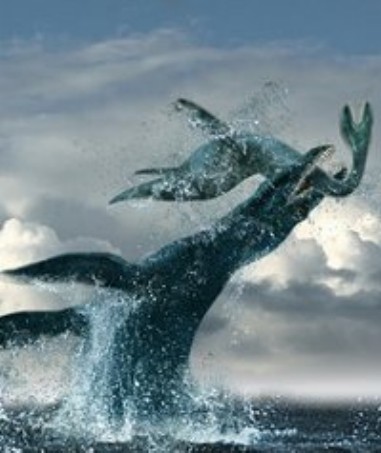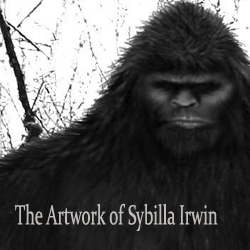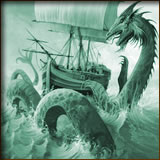Arctic Sea Monsters
Posted by: Craig Woolheater on October 7th, 2006
Scientists have found a fossil of a monster fish-like reptile in a 150 million-year-old Jurassic graveyard on an Arctic island off Norway.
The Norwegian researchers discovered remains of a total of 28 plesiosaurs and ichthyosaurs at a site on the island of Spitsbergen, about 1300 kilometres from the North Pole.
At the time these were the top marine predators, when dinosaurs dominated on land.
"One of them was this gigantic monster, with vertebrae the size of dinner plates and teeth the size of cucumbers," says Dr Joern Hurum, an assistant professor at the University of Oslo.

The bus-sized monster catching a smaller plesiosaur (Image: Natural History Museum, University of Oslo, Norway/Tor Sponga, BT)
"We believe the skeleton is intact and that it’s about 10 metres long," he says of the pliosaur, a type of plesiosaur with a short neck and massive skull. The team dubbed the specimen The Monster.
Such pliosaurs are known from remains in countries including the UK and Argentina but no complete skeleton has been found, Hurum says.
The skull of the pliosaur, perhaps a distant relative to Scotland’s mythical Loch Ness monster, is among the biggest on record.
Scientists will return next year to try to excavate the entire fossil, buried on a hillside.
Plesiosaurs, which swam with two sets of flippers, often preyed on smaller dolphin-like ichthyosaurs. All went extinct when the dinosaurs vanished 65 million years ago.
The scientists rate the fossil graveyard "one of the most important new sites for marine reptiles to have been discovered in the last several decades".
"It is rare to find so many fossils in the same place. Carcasses are food for other animals and usually get torn apart," Hurum says.
He thinks the reptiles did not die at the same time in some Jurassic-era cataclysm but died over thousands of years in the same area.
They then become preserved in what was apparently a deep layer of black mud on the seabed.
At that time, the area of Spitsbergen was under water several hundred kilometres further south, around the latitude of Anchorage or Oslo.
Hurum says the presence of fossils is also an interesting pointer for geologists hunting for oil and gas deposits in the Barents Sea to the east.
"A skull we found even smells of petrol," he says.
Source: ABC (Australian Broadcasting Corporation) Science Online
About Craig Woolheater
Co-founder of Cryptomundo in 2005.
I have appeared in or contributed to the following TV programs, documentaries and films:
OLN's Mysterious Encounters: "Caddo Critter", Southern Fried Bigfoot, Travel Channel's Weird Travels: "Bigfoot", History Channel's MonsterQuest: "Swamp Stalker", The Wild Man of the Navidad, Destination America's Monsters and Mysteries in America: Texas Terror - Lake Worth Monster, Animal Planet's Finding Bigfoot: Return to Boggy Creek and Beast of the Bayou.









Cool. And did you see the story of the big whale beached on the West Coast? What other mysteries of the deep await us?
That is a very cool find.
This is really fanstastic news. These water dwellers were remarkable reptiles, so just remember the next time you are on a boat and see a strange wake breaking on the water and you see a reptile that should be extinct. There are many mysteries not solved in bodies of water. Perhaps this giant reptile is what may be roaming in Lake Okanagan, it sure fits the description.
I think this is awesome. Although in order for the specimen(s) to be preserved so well, the black mud would have to cover them almost immediately, as in a mud slide or a flood with great upheaval. There’s no way that much “food” would go unnoticed long enough for the black mud to just slowly cover. Also, the petrol part, that’s why I have always wondered if the ancient earth’s crust didn’t have a vast network of caves that allowed water in. I would explain how such large animals got trapped in places that they really shouldn’t be. That would also explain why the earth’s crust is now fractured and moving.
Interesting find. Although it’s makes me cringe everytime I see the words Plesiosaur and Loch Ness together. I thought that theory should have gone the way of bell-bottomed jeans did in the 70’s.
Nobody thought it incongruous that a warm sea water loving reptile that hasn’t been found in recent form for millions of years would make a home in a cold fresh water lake that only came into existece a few thousand years ago at the end of the last great ice age.
It only became popular when someone said peoples descriptions of what they saw closely resembled a Plesiosaur.
If any of these things were still around, you’d know for sure because they would be eating all the people they could. I doubt there are any living in lakes these days.
very exciting find!
Joppa,
what big whale news? Any links?
Here is the link to the whale news.
Interesting and sad about the whale. I’ve always had a soft spot for the big guys!
On the plesiosaur news, very interesting indeed. I’m not one to say that the creature(s) in Loch Ness is a plesiosaur, however to say it can’t be because it would do this or it would be that, to me that’s the height of human hubris. The fact is we don’t know because few if any have ever observed a live plesiosaur. When you have, then you can tell me what they would or would not do, or where they might or might not be found.
There is no real evidence that points to a plesiosaur in Loch Ness. Whatever is in there, if anything, could be a lot of different things. Maybe it is a plesiosaur, maybe not. It is too bad when journalists make these jumps and make statements like that. Not only do they claim what is in the Loch is a plesiosaur, but they say it is mythical, which although it may be true, is not wholly confirmed.
I say one thing whatever is making those humps and can cause huge washes and wakes got to be one hell of a huge animal, don’t rule out it being some sort of sea dragon. Dont also forget eyewitnesses keep describing this animal having a long tapering neck so what kind of animal has a long tapering neck feature that it being A PLESIOSAUR OR ELMASAURUS. There also long neck and short neck.
Or it could be a long, tapering eel or a long necked whale of some kind, or something other than a plesiosaur. A lot of theories floating around. Let’s not make the mistake of making it into what we want it to be. That it is huge is well documented. What exactly it is is not.
Nobody really knows whats at the bottom of Loch Ness. You believe what you want, but I’ve done my research on the loch, and there can be many conclusions to what it is. Loch Ness is dark and gloomy and it is very difficult to journey done there. I had an encounter many years ago on a lake in Maine and that’s when I started my research on lake dwellers, because strange wakes and strange waves come out of no where no apparent reason. Well I encountered something like that, and no that in a lot of lakes there are strange animals in those body of water.
That image sure makes for an impressive sight and I really hope something like that could still exist somewhere in the oceans deep.
It kind of looks like the beast that I think the leviathan was. Kronosaurus and its relatives are really cool. Plesiosaurs and pliosaurs forever!